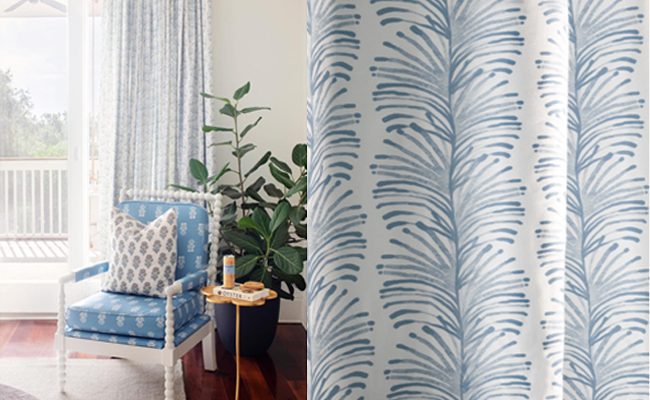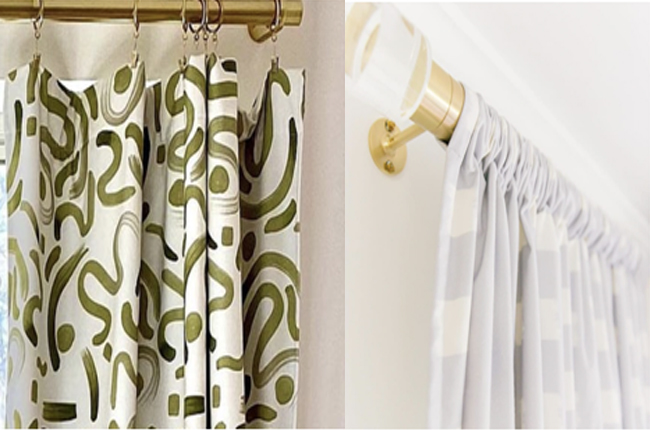
Two years ago, I moved into an apartment in which I had two windows in my somewhat narrow, rectangular bedroom. One was large and square, covering much of the back wall (the short end of the rectangle) and one was more of a standard window size on the longer wall of the room. As I decorated this room from top to bottom, I realized curtains were going to be a must, largely for practical reasons; the light that flooded the room in the morning would blind me upon waking up each day, and I had neighbors, so I needed some privacy. But when I began poking around online for curtains that would get the job done, I quickly realized these may serve more of a purpose than just blocking out the light. They could actually tie the whole room together.
In this way, curtains really are the unsung hero of a room. Typically not the first thing you consider as you begin decorating, they can bring a completely different energy to the room you put them in and selecting the right ones for the vibe you’re after can be a process. You’ll find yourself choosing length, thickness, material, and pattern, and each decision makes a big difference in the overall appearance of the room. A set of floral curtains, for example, can add a pop of color and pattern to a room that otherwise maintains a solid-colored theme. A set of velvet curtains takes on an entirely different tone. Below are a few options to consider when selecting your curtains… and how the choice might affect the room they’re in.
Long or Short? What’s In Right Now
One of the easier decisions of this process is how long you want your curtains to be. Some say curtains should always be long, hanging to just above the floor at the very least, regardless of window size. Some say it depends on the room. So which should you choose?
- Long Curtains: Generally, a longer curtain brings a slightly more dressy look to the room, which is the modern style right now and the choice many curtain enthusiasts would recommend. This isn’t to say long curtains will make your room look like a tea room or a formal dining room; it just adds a hint of maturity to a room, and the rest of the details are up to you. Longer curtains are also known to make a short window appear longer, and can even help a room with low ceilings appear to have more height. With long curtains also comes the choice of just how long; if you want to go with what’s in vogue, they should fall ¼ of an inch to ½ of an inch above the ground, and they should be hung to cover about ⅔ of the space between the window and the ceiling. The higher they’re hung, the higher the ceiling will appear.
- Short Curtains: Short curtains are less of the “in” choice, but they can have their uses as well. Some windows are significantly wider than they are long; in this case, long curtains could look unbecoming and out of place. Additionally, short curtains are often placed in childrens’ rooms for various reasons, like for preventative damage control with rowdy kids who might be interested in using them for play. In these cases, short curtains can still look fantastic and add a pop of color or a pattern to the room while still serving the purpose of ensuring privacy and blocking out light.
Room Decor Style: Finding The Right Match
It’s easy to imagine how a set of heavy, warm-colored velvet curtains might look out of place on windows in a minimalist or Scandinavian style room, full of white and light colors and a modern, sleek design. That’s a fairly dramatic example, but it shows why matching your curtains to your style of decor matters. If your style veers towards the modern, minimalist style, or even takes on a bohemian look, then light-colored sheer curtains match well, allowing light into the room while also maintaining privacy when desired. If your style is more mid century modern, with wooden furniture and large windows, deeper, warmer colored curtains or curtains with a geometric pattern would fit the mold. But if you’re not entirely sure which style your home falls under, you could simply consider the ways the curtains could complement the room’s unique style.
In a beachy home with light colors and an airy vibe, low-key floral curtains or curtains with a soft-colored pattern could add a lot to the room without stealing the show or standing out too much. Linen white curtains also fit the mold for many rooms that are aiming to harness natural light. And if you want to go for a pattern, the green light is always on. A leather couch, for example, is well-complimented by a floral curtain set or a set of patterned curtains. Or a patterned couch could be complimented by a solid set of curtains that bring out a color in the couch, or a patterned set of curtains that provide a fitting contrast. The colors and patterns team up to bring life to a room in a way few other decor items and accessories have the ability to do.
If you’re decorating a bedroom, follow a similar set of rules: select a color that may appear in small increments around the rest of the room that can tie the theme together. You’ll likely want to go with a thicker style to keep light out in the mornings.
Other Considerations
- Heading Styles: When I dove into curtain research, this was the first topic I stumbled upon and was surprised to see how much consideration goes into this factor. The first choice to make is whether or not you want your curtain on a rod or on a track. If you choose a rod, which is the most common, then you next select what you want the top of the curtains to look like. Do you want a rod pocket, a single pocket that extends the width of the curtain that the entire rod slides into in one fell swoop? Or do you want curtain rings, which you attach to the top of the curtain and can slide easier across a curtain rod while also potentially adding their own decorative flair?

You can also go with the eyelet style, in which metal curtain rings are embedded into the top of the curtain. Or, with tab top style curtains, the top of the curtain continues up into tabs at the top (as the name implies), rather than ending with a straight top, and the tabs act as loops that a curtain rod can slide into. They may tie into loops or be already shaped into loops, depending on the look you’re going for.
- Pemlets and Valences: These are a purely decorative addition to the curtain that are placed at the top of the curtain and cover the curtain rod. They can be plain and rectangular, just serving the purpose of covering the rod, nothing more, or they may have a shape that frames the window and adds more of an elegant look. Rectangular ones typically go well with more modern or simple styles. Any additional shape or texture takes things up a notch.
- Blinds: One more factor to take into consideration is whether or not you want blinds (or already have them) in addition to the curtains. If you have them, it gives you a little more flexibility in choosing your curtain style, as privacy is less of an issue and blinds can do a pretty good job at keeping out the light as well. Thus, if you go with a set of blinds, you can choose your curtains almost solely on how they complement the room’s aesthetic, rather than worrying as much about their material or function.
Overall, when choosing the right curtains for a room, just remember that while you could take the easy way out and get the simplest set you find at your nearest department store, you could also take advantage of the full potential of a good set of curtains. Let them tie the room together.
Leave a Reply